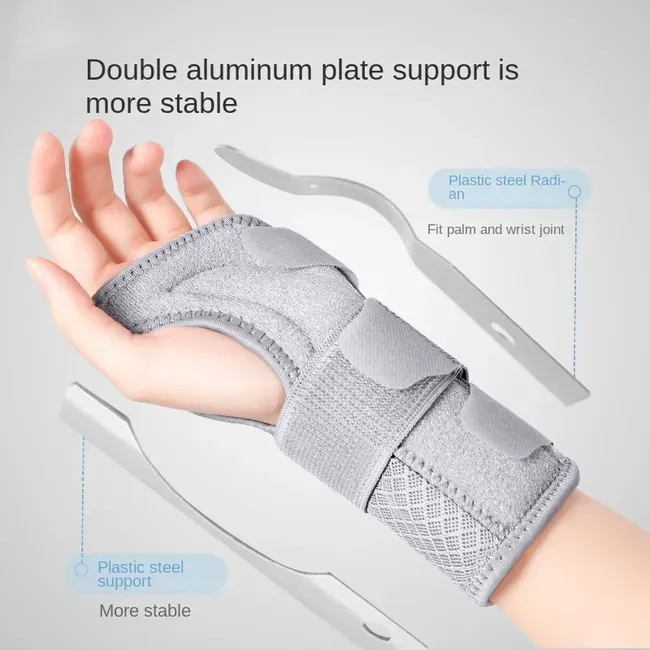john@lee-mat.com
+86-13510662576

GET QUOTE
Does Wrist Support Help Carpal Tunnel?
Struggling with the nagging discomfort of Carpal Tunnel Syndrome? You're not alone. This condition, marked by tingling, numbness, and pain in the hand and wrist, affects countless individuals. But there's hope on the horizon. Enter the world of wrist supports – a simple yet effective remedy that might just be the key to unlocking comfort and relief. In this article, we unravel the mystery: Does wrist support help carpal tunnel?
What is Carpal Tunnel Syndrome?
Carpal Tunnel Syndrome (CTS) is a common condition that affects the hand and arm. It occurs when the median nerve, which runs from the forearm into the palm, becomes pressed or squeezed at the wrist. This condition is often caused by a combination of factors like repetitive hand movements, wrist anatomy, or certain health conditions. Symptoms typically include numbness, tingling, and pain in the hand and arm, particularly in the thumb and fingers except the pinky.
How Wrist Supports Work in Carpal Tunnel Relief?
Wrist braces or supports are more than just a bandage for your wrist; they are a functional tool designed to combat the symptoms of Carpal Tunnel Syndrome. The primary way they offer relief is by maintaining the wrist in a straight, neutral position. This posture is crucial because it reduces the pressure exerted on the median nerve – the central nerve affected in CTS.
Nighttime Relief
Many people unknowingly bend their wrists while sleeping. This bending increases pressure on the median nerve, leading to heightened symptoms like numbness and tingling upon waking. A wrist brace acts as a preventive measure against such involuntary movements. According to a 2012 study, using a wrist brace at night proved more effective in relieving carpal tunnel symptoms than not using any treatment. This night-time usage can significantly reduce morning symptoms, leading to a more comfortable start to your day.
Daytime Use
Wrist braces are not just limited to nighttime use. Wearing them during the day, especially when engaging in activities known to trigger CTS flare-ups, can be immensely beneficial. Activities that involve repeated motions or put extra strain on the wrist – like typing, using tools, or certain sports – can exacerbate symptoms. A wrist brace provides support and restricts movements that might aggravate the condition. For those whose jobs contribute to CTS symptoms, wearing a wrist brace at work can be a practical solution, as long as it doesn't impede essential job functions.
Post-Use Practices
It's important to note that while wrist braces are helpful, they are not a permanent fixture. After removing the brace, it's essential to keep the wrist moving as normally as possible. Regular movement keeps the wrist muscles flexible and strong, which is vital for overall wrist health. However, caution should be exercised to avoid excessive stress or force on the wrist, especially immediately after removing the brace.
The Balancing Act
The effectiveness of wrist supports in managing Carpal Tunnel Syndrome lies in balancing immobilization with normal wrist activity. By providing support and reducing strain on the median nerve, these braces play a significant role in managing the discomfort and pain associated with CTS. Their correct use, combined with mindful wrist activity, forms a comprehensive approach to managing and potentially easing the symptoms of Carpal Tunnel Syndrome.
Types of Wrist Supports for Carpal Tunnel
Wrist supports can effectively manage pain during various activities and rest periods. By providing support and stability, they can improve the overall functionality of the hand and wrist, enhancing the quality of life for individuals with CTS. There are various types of wrist supports available, each designed to meet different needs. Understanding these variations is key to selecting the right support for your condition.
Adjustable Wrist Braces
Adjustable wrist braces are popular for their versatility. They typically feature Velcro straps that allow users to customize the fit and level of support. This adjustability is particularly beneficial as it accommodates fluctuations in wrist size due to swelling or changes throughout the day. Adjustable braces are ideal for those seeking a balance between support and flexibility.
Rigid Wrist Splints
For those needing more stringent support, especially during the night, rigid wrist splints are the go-to option. These splints usually have a hard plastic or metal support running along the underside of the wrist and palm. The rigidity ensures the wrist remains in a neutral position, thereby reducing pressure on the median nerve. They are less flexible but offer maximum support to prevent wrist movements that could exacerbate CTS symptoms.
Wrap-Around Braces
Wrap-around braces are a simpler form of wrist support, offering a more general level of support. They wrap around the wrist and are secured with Velcro, providing a comfortable and easily adjustable fit. While they may not offer as much support as a rigid splint, they are a good option for mild CTS symptoms or for those who require a brace that is easy to put on and take off.
Glove Braces
Glove braces are a unique type, combining the features of a glove and a brace. They offer support while allowing more freedom of movement for the fingers, making them suitable for daytime use, especially for those who need to perform finer tasks with their hands.
Material Considerations
The material of the wrist support is a crucial factor. Breathable fabrics like neoprene or lightweight blends are preferable for comfort, especially for those who need to wear the brace for extended periods. Skin-friendly materials reduce the risk of irritation or discomfort during use.
Best Practices for Wrist Support Usage
It's important to wear wrist supports as recommended, typically during activities that trigger symptoms and at night. Proper adjustment is crucial to ensure they are effective without being too tight. Alongside wearing supports, integrating hand exercises and ergonomic adjustments at the workplace or home can further alleviate symptoms.
Alternative Treatments and Preventive Measures
Besides wrist supports, treatments like physical therapy exercises, medications, and in severe cases, surgery, can be considered. Preventive measures include practicing good workplace ergonomics, taking regular breaks, and performing hand exercises. Lifestyle changes, such as reducing repetitive hand activities and maintaining a healthy weight, can also help manage or prevent CTS.
How to Select Your Wrist Support for Carpal Tunnel
Choosing the right wrist support involves considering fit, comfort, and individual needs. Consulting with a healthcare professional can provide tailored recommendations. When purchasing a wrist support, factors like durability, price, and user reviews should be considered to ensure you select a product that meets your specific requirements.
Conclusion
Wrist supports can be a valuable tool in managing Carpal Tunnel Syndrome. They offer relief, improve functionality, and can prevent symptom progression. However, it's important to choose the right type and use it correctly. Remember, while wrist supports can provide significant benefits, they are just one part of a comprehensive approach to managing CTS.

